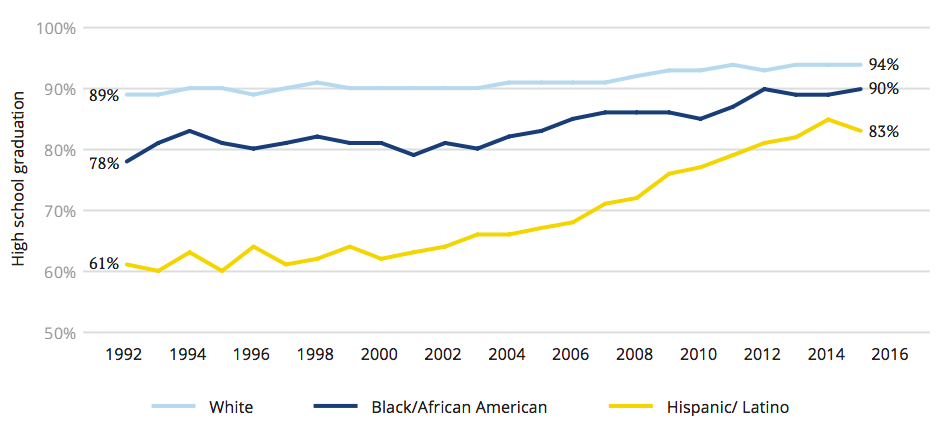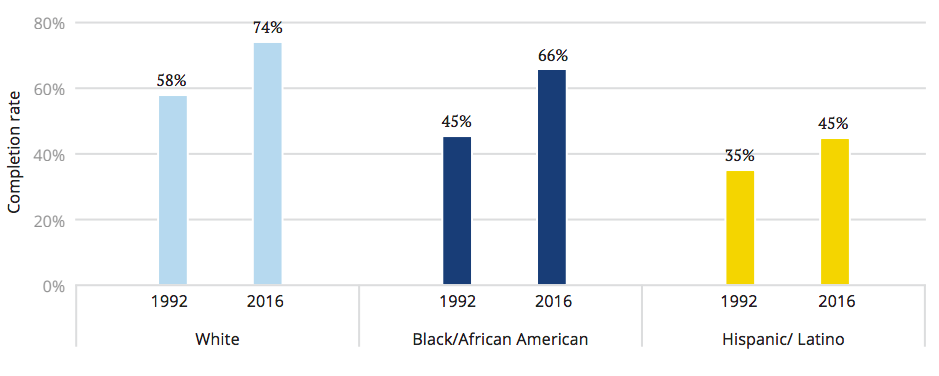Latinos have made improvements in their high school graduation rates but are falling behind other populations in college attainment, says a new report from the Georgetown University Center on Education and the Workforce. In Latino Education and Economic Progress: Running Faster but Still Behind, it is argued that as a result of their low high school graduation rates, Latinos lag behind other ethnic groups in postsecondary enrollment. While their completion rates for certificate programs exceed those of blacks and whites, they still have the lowest college attainment of the three groups.
One of the reasons it has been difficult for Latinos to make economic progress is that today’s working Latinos cannot reap the same economic benefits that prior generations enjoyed from having good jobs that only required high school. Instead, they must acquire at least some college in order to enter the middle class.
Latino high school graduation rates have increased over 20 percentage points from 1992-2016.
The Latino high school completion rate is behind white and black completion rates but is growing the fastest, gradually narrowing race-based completion gaps.
Latino, Black, and White high school graduation rates, 1992-2016
Latino college enrollment rates are increasing faster than their white and black peers.
Latinos are also enrolling in colleges faster than their college-age population share is growing. As a result, the overall college enrollment share of Latinos is closer than ever to their growing population share: Latinos account for 21% of the college-age population and 19% of college enrollment.
Latinos also have the highest completion rate for certificates (60%), compared to blacks (37%) and whites (47%).
Latinos are running faster in the education race, but are actually falling further behind whites and blacks in many crucial college outcomes.
While Latinos are climbing faster up the education pipeline, they are actually falling further behind because their population growth is increasing faster than their college attainment. Between 1992 and 2016, the Latino population share grew by 9 percentage points, while the share of Latinos with at least some postsecondary education grew by 6 percentage points.
Latino, Black, and White college completion rates, 1992 vs. 2016
Latinos tend to enroll in college at the sub-baccalaureate level and at open-access institutions.
Almost two-thirds (65%) of Latinos initially enroll in certificate or associate degree programs, compared to 42% of whites and 52% of blacks. Only 35% of Latinos enroll directly in bachelor’s degree programs.
65% of first-year Latino students enroll in open-access colleges compared to 15% enrolling in selective colleges. Meanwhile, whites are leaving the open-access college sector: Since 2004, white enrollment in open-access two- and four-year colleges has declined by 18%. Like Latinos, blacks have also increased their open-access enrollment, but only by 13%.
Latinos’ educational progress has left them primarily in the middle tier of educational attainment between high school and bachelor’s degrees and, as a result, they are primarily in the middle-skill sub-baccalaureate labor market.
Source: Latino Education and Economic Progress: Running Faster but Still Behind, Anthony P. Carnevale and Megan L. Fasules. Georgetown University Center on Education and the Workforce, 2017.



